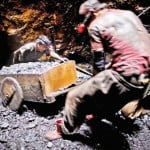
Coal contributes more to climate change than any other energy source. Photo: Bloomberg
New Delhi: The amount of coal used to produce power has nearly quadrupled in India since 1990, alleviating India’s energy access problem and contributing to poverty reduction. But this has come at substantial health, social and environmental costs, according to ‘Coal Atlas 2015’, a report released by the Heinrich Böll Foundation (the Green political foundation from Germany) and Friends of the Earth International in Brussels late Wednesday.
Both Heinrich Böll Foundation and Friends of the Earth International are non-governmental organisations working on environmental issues.
The Coal Atlas contains the latest facts and figures on the use of coal and its environmental and social consequences, illustrating coal’s impact on nature, health, labour, human rights and politics. It also sheds light on the beneficiaries of coal production and shows the current developments of the sector in countries like India, China, the US, Russia and Germany.
“In India, power production and the amount of coal consumed to produce it nearly quadrupled between 1990 and 2013. The percentage of the population living below the poverty line fell by about one-third, while the proportion of the population with access to electricity rose from half to more than three-quarters,” said the report.
“Thus, coal has alleviated India’s energy access problem and contributed to poverty reduction—but this has come at substantial health, social and environmental costs. And yet each Indian consumes the equivalent of only 0.47 tonnes of oil a year—less than a third of the world average,” the report added.
The report comes ahead of the Paris climate change summit starting 30 November, in which over 190 nations will seek to negotiate a new global climate regime.
Coal contributes more to climate change than any other energy source. In 2014 it was responsible for 14.2 gigatonnes of CO2 (carbon-dioxide) emissions, making up 44% of all energy-related carbon dioxide emissions and more than a quarter of all greenhouse gas emissions.
Additionally, the extraction and burning of coal causes irreversible damage to the environment and health. Other effects of the coal industry include forced removals and repression of local residents.
The report revealed that in the European Union (EU), coal-related health problems cost up to 43 billion euros every year.
“The Coal Atlas 2015 proves that there is no such thing as clean coal. Europe is still one of the leading coal consumers. Even in 2015, Europe still suffers from devastated landscapes because of huge coal mining projects, especially in Germany, and from toxic emissions in coal-dependent countries such as Poland,” says Jagoda Munic, chair of Friends of the Earth International.
The Coal Atlas makes it clear that Europe needs to shift away from what it called its undemocratic, irresponsible and unjust energy system into one that is socially-controlled, climate-safe and fair. But Munic said resistance to plans to phase out coal in Europe indicates that the EU is in the grip of a powerful industrial coal lobby.
Barbara Unmüßig and Ralf Fücks, presidents of the Heinrich-Böll-Stiftung, also urged the EU to take action stressing the need for the 28-nation grouping to stop supporting coal projects with taxpayers’ money.
The report also said that global players have started to look for alternative energy sources.
“While India’s coal usage is still rapidly growing, the country expands its renewable energy as well. India and Russia continue to rely on coal consumption in order to maintain economic growth. This is possible only thanks to subsidies; without them, electricity from coal would cost as much as twice the current price,” the report said.
Similarly, in the US, coal companies are heading toward bankruptcy due to a market shift to renewable and other energy sources.
In 2014, China’s coal consumption went down for the first time in over three decades, while the Chinese government pushes for rapid expansion of renewable energy, the report said.
[“source -livemint”]




